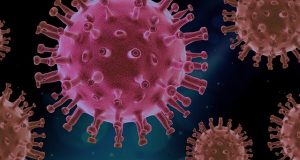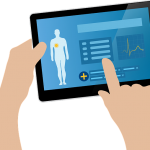From the CDC Vaccine Task Force
 Our top priority remains protecting the American people from COVID-19. COVID-19 vaccination, wearing masks, physical distancing, testing, contact tracing, quarantine and isolation, and improvements to building ventilation systems are critically important to reduce the transmission of SARS CoV-2, the virus that causes COVID-19.
Our top priority remains protecting the American people from COVID-19. COVID-19 vaccination, wearing masks, physical distancing, testing, contact tracing, quarantine and isolation, and improvements to building ventilation systems are critically important to reduce the transmission of SARS CoV-2, the virus that causes COVID-19.
What we know about the Delta
The Delta variant causes more infections and spreads faster than early forms of SARS-CoV-2. Currently, the Delta variant is the predominant genetic variant in the United States. CDC is following the science as the SARS-CoV-2 virus changes. We are committed to providing up-to-date information as more data are available. Variants and Genomic Surveillance for SARS-CoV-2 | CDC
- The Delta variant is more contagious. The Delta variant is highly contagious, nearly twice as contagious as previous variants.
- Some data suggest the Delta variant might cause more severe illness than previous genetic variants in unvaccinated persons. In two different studies from Canada and Scotland, patients infected with the Delta variant were more likely to be hospitalized than patients infected with Alpha variant or the original virus strain. The COVID-19 vaccines authorized in the United States are highly effective at preventing severe disease and death from COVID-19, including against the Delta variant. Though they are not 100% effective in preventing infection or transmission, the vaccines provide strong protection against serious illness and death. Most people who are fully vaccinated and who become infected with the Delta variant are much less likely to have severe outcomes such as such as death from COVID-19.
- The greatest concern is for people who are unvaccinated: The greatest risk of transmission and severe illness is among unvaccinated people who are much more likely to contract, and therefore transmit, the virus. Low vaccination coverage in many communities is driving the current rapid and large surge in cases associated with the Delta variant, which also increases the chance that the virus will change and may spread more easily than other variants, or make it resistant to treatments or vaccines.
- Fully vaccinated people with Delta variant breakthrough infections can spread the virus to others. However, vaccinated people appear to be infectious for a shorter period. The Delta variant seems to produce the same high amount of virus in both unvaccinated and fully vaccinated people, when infected. However, like other variants, the amount of virus produced by Delta breakthrough infections in fully vaccinated people throughout their course of illness also goes down faster than infections in unvaccinated people. This means fully vaccinated people are likely infectious for less time than unvaccinated people.
Importance of using all prevention strategies available
We know that COVID-19 prevention strategies work. At this critical point in the pandemic, we need to focus on layered mitigation strategies. Vaccination, masking, testing, physical distancing, case investigation and contact tracing, quarantine and isolation, and other layered mitigation strategies are critical to stop transmission and end the pandemic. Layered mitigation efforts along with safe, effective, and long-lasting vaccines will give all communities the best chance of ending the COVID-19 pandemic.
- Primary series of vaccination:
- It is critical that unvaccinated and partially vaccinated people get and complete their primary series of vaccines to further reduce the risk of COVID-19 and more severe outcomes. Most cases of severe disease, hospitalization, and death continue to occur among those not yet vaccinated at all.
- Vaccines remain the most powerful tool we have against COVID-19.
- Masking:
- In areas with substantial and high transmission, everyone (including fully vaccinated people) should wear a mask in public indoor settings to help prevent spread of Delta and protect others.
- Social distancing:
- CDC recommends that individuals give at least six feet of distance between themselves and others who do not live in their household.
- Inside your home: Avoid close contact with people who are sick. If possible, give at least 6 feet between the person who is sick and other household members.
- Outside your home: Give at least 6 feet of distance between yourself and people who don’t live in your household. Remember that some people without symptoms may be able to spread virus.
- Testing:
- A robust and responsive testing infrastructure is essential for success in stopping the spread of SARS-CoV-2, the virus that causes COVID-19.
- CDC recommends that anyone with any signs or symptoms of COVID-19 get tested, and stay away from others pending test results, regardless of vaccination status or prior infection.
- IN SCHOOLS: o Students, teachers, and other staff members who have symptoms of infectious illness, such as influenza (flu) or COVID-19, should stay home and contact their healthcare professional for testing and care, regardless of vaccination status. Getting tested for COVID-19 will help with rapid contact tracing and prevent possible spread at schools, especially if key prevention strategies (masking and distancing) are not in use.
CDC’s Guidance for COVID-19 Prevention in K-12 Schools provides recommendations to K-12 schools on testing strategies for identifying and distinguishing SARS-CoV-2 from other respiratory infections.
The Epidemiology and Laboratory Capacity for the Prevention and Control of Emerging Infectious Diseases (ELC) Cooperative Agreement Reopening Schools: Support for Screening testing to Reopen & Keep Schools Operating Safely provided $10 billion to implement detection and screening testing programs in schools. Additional resources to support implementation are available at Open and Safe Schools.
- IN BUSINESSES:
- Workplace-based testing for SARS-CoV-2, the virus that causes COVID-19, could identify workers with SARS-CoV-2 infection, thus help prevent or reduce further transmission.
- Employers paying for testing of employees should put procedures in place for rapid notification of results and establish appropriate measures based on testing results, including instructions regarding self-isolation and restrictions on workplace access.
- Testing Strategy for Coronavirus (COVID-19) in High-Density Critical Infrastructure Workplaces after a COVID-19 Case Is Identified | CDC
- Workplaces and Businesses | COVID-19 | CDC
- Ventilation:
- CDC recommends a layered approach to reduce exposures to SARS-CoV-2, the virus that causes COVID-19. This approach includes using multiple mitigation strategies, as well as improvements to building ventilation, to reduce the spread of disease and lower the risk of exposure.
- When indoors, ventilation mitigation strategies can help reduce viral particle concentration. Protective ventilation practices and interventions can reduce the airborne concentrations and reduce the overall viral dose to occupants.
- Case investigation and contact tracing:
- Case investigation and contact tracing, a core infection control measure employed by local and state health department personnel for decades, is a key strategy for preventing further spread of COVID-19. Communities must scale up and train a large workforce and work collaboratively across public and private agencies to stop the transmission of COVID-19.
- As schools and institutions of higher education (IHEs) resume in-person learning, case investigation and contact tracing are effective strategies to identify people infected with SARS-COV-2, the virus that causes COVID-19, and to reduce transmission.
- The case investigation and contact tracing workforce can help connect people to important services and resources, such as COVID-19 vaccination.
- Health departments experiencing surge or crisis situations around COVID-19 should prioritize case investigation interviews of people who tested positive for or were diagnosed with COVID-19 in the past 6 days (based on specimen collection date or symptom onset, if known). They should also focus contact tracing efforts on household contacts exposed in the past 6 days, and people living, working, or visiting congregate living facilities, high density workplaces, or other settings (or events) with potential extensive transmission.
- Quarantine and isolation:
- Prompt isolation of people diagnosed with COVID-19, and identification and quarantine of close contacts, can effectively interrupt disease transmission and reduce the spread of SARS-CoV-2.
- Contact tracing slows the spread of COVID-19. Close contacts who have been exposed to someone with COVID-19 should stay at home and self-quarantine according to CDC and local public health guidelines.
- Quarantine means to stay home. Isolation means to stay away from other people.
Healthy equity strategies
Persistent health disparities have put members of some racial and ethnic minority populations and other population groups at increased risk of getting sick, having more severe illness, and dying from COVID-19. There is a need to prioritize vaccine equity for racial and ethnic minority groups and other population groups disproportionately affected by addressing potential barriers and access issues.
CDC’s COVID-19 Response Health Equity Strategy broadly seeks to improve the health outcomes of populations disproportionately affected by focusing on four priorities:
- Expanding the evidence base,
- Expanding programs and practices for testing, contact tracing, isolation, healthcare, and recovery from the impact of unintended negative consequences of mitigation strategies in order to reach populations that have been put at increased risk,
- Expanding program and practice activities to support essential and frontline workers to prevent transmission of COVID-19, and
- Expanding an inclusive workforce equipped to assess and address the needs of an increasingly diverse U.S. population.
Funding to Support Prevention Strategies
CDC has awarded more than $30 billion to 64 state, local and territorial jurisdictions through the ELC Cooperative Agreement to support expanded testing capacity for COVID-19, contact tracing, surveillance, and other prevention activities. This includes $10.25 billion for Enhancing Detection and $19.11 billion for Enhancing Detection Expanded awards. This funding is available through July 2023 to support ongoing COVID-19 response needs.
Additional resources
- COVID-19 Health Equity
- COVID-19 Communication Resources
- COVID-19 Toolkits
- Pregnant People and New Parents
- Stop the Spread
- COVID-19 Vaccines • COVID-19 Vaccine Equity for Racial and Ethnic Minority Groups
- Health Departments and Public Health Partner Vaccination Toolkit
- Vaccination Communication Toolkit
- Recipient Education Toolkit
- Long-Term Care Facility (LTCF) Vaccination Toolkit
- Essential Worker Vaccination Toolkit
- Community-Based Organization (CBO) Vaccination Toolkit
- School Settings and Childcare Programs Toolkit
- Social Media Toolkit
- Contact Tracing Communications Toolkit for Health Departments
- COVID-19 Contact Tracing Communications Graphics
- COVID Data Tracker Communications Toolkit
- COVID-19 Science Briefs
- COVID Data Tracker
- CDC COVID-19 Response Health Equity Strategy: Accelerating Progress Towards Reducing COVID-19 Disparities and Achieving Health Equity
Data references: Delta infectiousness and disease severity for unvaccinated and vaccinated individuals
- Bernal JL, Andrews N, Gower C, et al. Effectiveness of Covid-19 Vaccines against the B.1.617.2 (Delta) Variant. N Engl J Med. 2021 Jul 21;doi:10.1056/NEJMoa2108891.
- Brown CM, Vostok J, Johnson H, et al. Outbreak of SARS-CoV-2 Infections, Including COVID- 19 Vaccine Breakthrough Infections, Associated with Large Public Gatherings — Barnstable County, Massachusetts, July 2021. MMWR Morb Mortal Wkly Rep. ePub: 30 July 2021; https://www.cdc.gov/mmwr/volumes/70/wr/mm7031e2.htm
- Chia PY, Ong SWX, Chiew CJ, et al. Virological and serological kinetics of SARS-CoV-2 Delta variant vaccine-breakthrough infections: a multi-center cohort study. 2021;doi. org/10.1101/2021.07.28.21261295.
- Dagpunar J. Interim estimates of increased transmissibility, growth rate, and reproduction number of the Covid-19 B.1.617.2 variant of concern in the United Kingdom. medRxiv. 2021;doi:doi.org/10.1101/2021.06.03.21258293.
- Fisman DN, Tuite AR. Progressive Increase in Virulence of Novel SARS-CoV-2 Variants in Ontario, Canada. medRxiv. 2021 Jul 12; https://doi.org/10.1101/2021.07.05.21260050.
- Li B, Deng A, Li K, et al. Viral Infection and Transmission in a Large Well-Traced Outbreak Caused by the Delta SARS-CoV-2 Variant. medRxiv. 2021 Jul 12; https://doi.org/10.1101/2021.07.07.21260122.
- Mlcochova P, Kemp S, Dhar S, et al. SARS-CoV-2 B.1.617.2 Delta Variant Emergence and Vaccine Breakthrough. Research Square Platform LLC. 2021 Jun 22; doi:10.21203/rs.3.rs- 637724/v1.
- Musser JM, Christensen PA, Olsen RJ. et al. Delta Variants of SARS-CoV-2 Cause Significantly Increased Vaccine Breakthrough COVID-19 Cases in Houston, Texas. medRxiv. 2021 Jul 22; https://doi.org/10.1101/2021.07.19.21260808.
- Nasreen S, Chung H, He S, et al. Effectiveness of COVID-19 vaccines against variants of concern in Ontario, Canada. medRxiv. 2021 Jul 16;doi:doi.org/10.1101/2021.06.28.21259420.
- Ong SWX, Chiew CJ, Ang LW, et al. Clinical and Virological Features of SARS-CoV-2 Variants of Concern: A Retrospective Cohort Study Comparing B.1.1.7 (Alpha), B.1.315 (Beta), and B.1.617.2 (Delta). SSRN Journal. 2021 Jun 7; https://doi.org/10.2139/ssrn.3861566.
- Riemersma KA, Grogan BE, Kirta-Yarbo A, et al. Vaccinated and Unvaccinated Individuals Have Similar Viral Loads in Communities with a High Prevalence of the SARS-CoV-2 Delta Variant. medRxiv. 2021 Jul 31; https://doi.org/10.1101/2021.07.31.21261387.
- SARS-CoV-2 variants of concern and variants under investigation in England, Technical briefing 19 Public Health England Technical Briefing 19. 2021 Jul 23;https://assets.publishing.service.gov.uk/government/uploads/system/uploads/attachment_data/file/1005517/Technical_Briefing_19.pdf
- Sheikh A, McMenamin J, TaylorB, Robertson C. SARS-CoV-2Delta VOC in Scotland:demographics, risk of hospital admission and vaccine effectiveness. The Lancet.2021;397(10293):2461-2462.doi:10.1016/ s0140-6736(21)01358-1.
- Stowe J, Andrews N, Gower C, et al. Effectiveness of COVID-19vaccines against hospital admission with the Delta (B.1.617.2) variant. 2021.https://khub.net/web/phe-national/public-library/-/document_library/v2WsRK3ZlEig/view_file/479607329
- ThompsonMG, Burgess JL,Naleway AL,et al. Prevention and Attenuation of COVID-19 with the BNT162b2 andmRNA-1273 Vaccines. N Engl J Med. 2021 Jul22;385(4):320-329.doi:10.1056/NEJMoa2107058. Epub 2021 Jun 30.PMID: 34192428; PMCID: PMC8262622.




